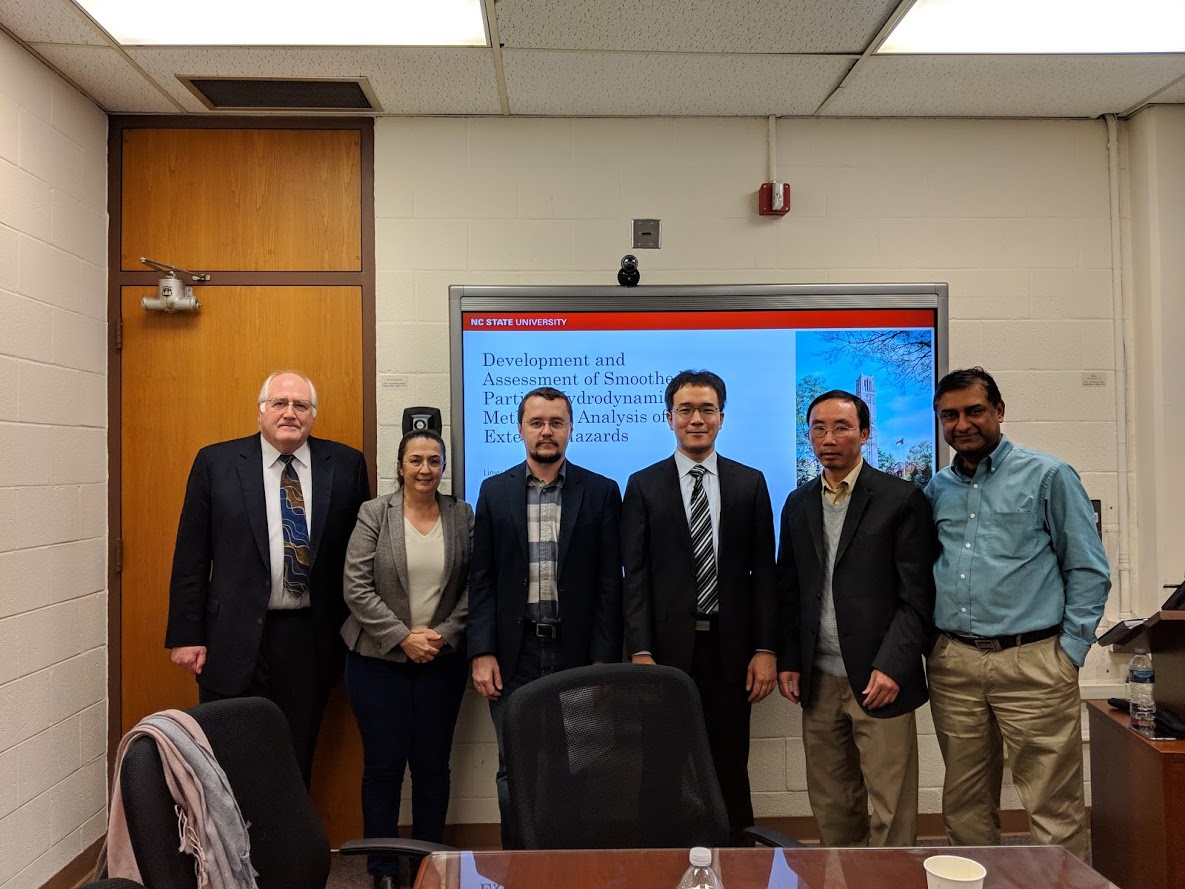On December 14, Linyu Lin successfully defended his PhD dissertation,Development and Assessment of Smoothed Particle Hydrodynamics Method for Analysis of External Hazards. Linyu’s committee consisted of his advisor, Nam Dinh, and members, Igor Bolotnov, Maria Avramova, Abhinav Gupta, and Robert Youngblood.
Abstract
LIN, LINYU. Development and Assessment of Smoothed Particle Hydrodynamics Method for Analysis of External Hazards. (Under the direction of Nam Dinh.)
Smoothed Particle Hydrodynamics (SPH), as a Lagrangian method, is one of the particle-based Computational Fluid Dynamics (CFD) methods. Because of the unique capability of SPH in handling large-scale fluid simulations with complex interfacial structures, SPH methods are used as the CFD tool for simulating the generation, propagation, and interaction of flooding and high wind with the Nuclear Power Plant (NPP). For the modern NPP risk analysis methodology named Risk-Informed Safety Margin Characterization (RISMC), SPH is first controlled by the statistical software, and multiple simulations are performed by sampling the initial and boundary conditions based on the uncertainty information of external hazards. Next, the simulation results, including the hazard trajectories and impacts on the reactor structure, system, and components, are fed back to the risk analysis tool for identifying the reactor vulnerability under uncertain external hazards and managing the reactor safety margin. The previous study assumes that SPH methods and simulation packages are applicable to the external-hazards risk analysis and that simulation uncertainties do not affect the confidence of safety decision. However, since the product of RISMC aims to inform and support the decision-making regarding the design, operation, and safety of NPP that has high consequences, a convincing validation process is needed to systematically assess the credibility of SPH simulations for designated scenarios. At the same time, considering the potential gaps between established validation framework and application requirements, new methodologies and techniques need to be developed and incorporated for improving the framework. Therefore, this study has two primary objectives: 1) assess the credibility of SPH methods as the RISMC simulation tool for external-flooding and high-wind risk analysis with established frameworks; 2) improve the assessment framework by identifying and bridging the gaps of practical issues and application requirements.
In this study, the well-established methodology Code Scaling, Applicability, and Uncertainty (CSAU) and its regulatory guide Evaluation Model Development and Assessment Process (EMDAP) are employed to assess the credibility of SPH methods. Expert opinions are elicited from the author’s knowledge, and validation data are collected from the literature. Next, adequacy decisions and performance conclusions are made for SPH methods according to the database scaling analysis and the assessment results. At the same time, framework issues and methodology insufficiency are identified accordingly. Attempting to bridge the gaps, three novel methodologies are proposed and formalized according to the application requirements. Meanwhile, case studies are set for demonstrating their capabilities and potential issues. In addition, the scopes of two additionally required methodologies are defined, and a flowchart of the improved CSAU/EMDAP framework is suggested. Finally, a summary of findings and contributions is made together with a discussion on future works.

